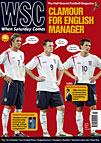 A new generation of football magazines has appeared in Europe of late, breaking the monopoly of established, establishment titles. The first of an occasional series looks at the subversion and humour attracting readers in France. Neil McCarthy reports
A new generation of football magazines has appeared in Europe of late, breaking the monopoly of established, establishment titles. The first of an occasional series looks at the subversion and humour attracting readers in France. Neil McCarthy reports
Publishing its 30th monthly edition in January 2006, S0 Foot is becoming firmly established as France’s main alternative football magazine with a print run of 80,000 and an estimated readership of more than 200,000. It’s not a mean feat, considering that French football is already largely covered by three mammoths: the daily L’Equipe, its bi-weekly stable mate, France Football, and the monthly Onze Mondial. L’Equipe and France Football both celebrate their 60th birthdays this year and Onze Mondial, France’s equivalent of Shoot!, its 30th.
In comparison, So Foot’s editor, Franck Annese, is proud to tell you that his magazine is “two-and-a-half years old”. Not many French magazines get beyond 12 months and Annese is as surprised as many to see sales increasing and money in the bank.
“It really started as a stupid dare. I was already editor of the cultural magazine Sofa and team-mates from our works football club said I should start a football magazine, too. My lack of enthusiasm was met with something childish like ‘Won’t do it, can’t do it!’ and it was enough to send me into a frenzy of writing crap-joke articles about football.” The result was distributed among friends in magazine format with the title So Foot and, although initially a joke, it became the basis for the first official So Foot, launched in April 2003. “What was funny, and quite telling for the future, was that this prototype was written just before the 2002 World Cup, yet not one single article made reference to the event.”
It could be described as a culturally aware magazine about football. It’s a true “glossy”, with full page ads for sports brands such as Nike and Umbro as well as Audi and France’s national lottery. The appearance is somewhat subversive, though. The content is rougher, with informal articles discussing philosophy, art, music and politics – often with showbiz celebrities – while never drifting too far from football. A lot of the editorial relates to in-jokes. There was an article detailing calls made to all the other Thierry Henrys in the French phone book; another, about the Brazilian transvestites working as prostitutes in Paris’s Bois-de-Boulogne (“A footballer, that’s exciting, it gives me a hard-on”), had the title “Boulogne Boys” – the name of Paris Saint-Germain’s skinhead ultra group.
It’s the fact that So Foot is so radically different from the established press that has helped it survive so long. First, it is not results or event orientated – although it has dedicated a large part of a recent edition to the late George Best. Second, it isn’t afraid of being critical of football or football personalities – and is even currently embroiled in court cases with a few, including the former Everton player Mickael Madar. Last, and most important for its creators, So Foot mixes culture and football in a country which they believe has traditionally considered them to be complete opposites. The 1998 World Cup and the latest big money TV deal served only to further distance the two.
So without meaning to be a fanzine – and especially not wanting to be an ultra magazine – So Foot has found itself relating to a large number of people who do go to football matches. And, surprise, surprise, it turns out that they are not the brainless, cultureless, proletarians that they have bee
n painted as for so long. They can appreciate both football and culture, and may even be concerned about “difficult subjects” such as the political and ethical implications caused by the money that has come into football. It also attracts readers from France’s ultras – not hooligan “crews”, as they are often portrayed, even in French ultra magazines, but, as Annese explains, “watered-down versions of what you find in Spain, Italy and England: social clubs finding a cheap way to get to away matches”.
The magazine draws a lot on English football culture and the editorial team own up to copying a lot from UK fanzines and football coverage. They look forward to their country’s football culture developing to a point where French football literature can emerge, and they believe that the pioneers may almost certainly be among their writers. More than 50 people, not all professional journalists, now write for the magazine and, as well as being proud of surviving for 30 editions, Franck Annese is also proud of being able to pay them all and the photographers, too.
However, along with the two other founder members, Sylvain Hervé and Guillaume Bonnamy, he doesn’t plan on giving up his day job. Comparing So Foot’s longevity to those of Onze Mondial and even When Saturday Comes, Annese says: “If the magazine is still around in 20 years, it will be without me. The whole ethos would change if we started taking it too seriously. And anyway it’s too much like hard work…”
From WSC 229 March 2006. What was happening this month